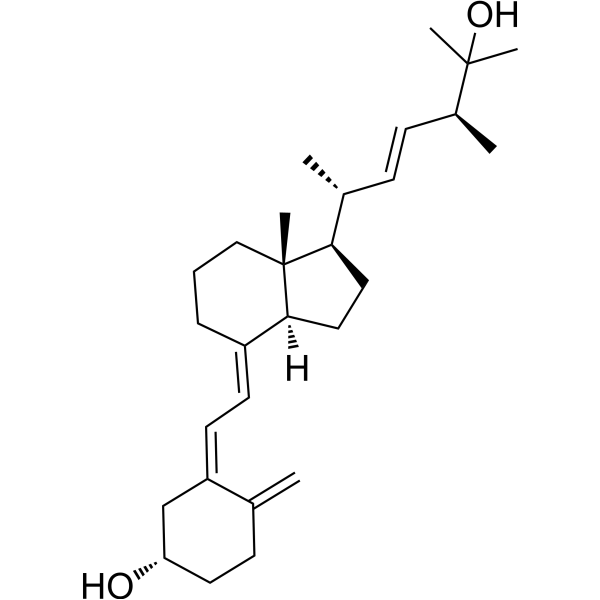
Ercalcidiol
CAS No. 21343-40-8
Ercalcidiol ( 25-hydroxy Vitamin D2 )
产品货号. M26679 CAS No. 21343-40-8
Ercalcidiol is a metabolite of vitamin D2 and can be used in monitoring vitamin D therapy.
纯度: >98% (HPLC)
 COA
COA
 Datasheet
Datasheet
 HNMR
HNMR
 HPLC
HPLC
 MSDS
MSDS
 Handing Instructions
Handing Instructions
| 规格 | 价格/人民币 | 库存 | 数量 |
| 5MG | ¥2811 | 有现货 |


|
| 10MG | ¥4496 | 有现货 |


|
| 25MG | ¥7266 | 有现货 |


|
| 50MG | ¥9963 | 有现货 |


|
| 100MG | ¥13365 | 有现货 |


|
| 200MG | 获取报价 | 有现货 |


|
| 500MG | 获取报价 | 有现货 |


|
| 1G | 获取报价 | 有现货 |


|
生物学信息
-
产品名称Ercalcidiol
-
注意事项本公司产品仅用于科研实验,不得用于人体或动物的临床与诊断
-
产品简述Ercalcidiol is a metabolite of vitamin D2 and can be used in monitoring vitamin D therapy.
-
产品描述Ercalcidiol is a metabolite of vitamin D2 and can be used in monitoring vitamin D therapy.(In Vitro):The half-life of Ercalcidiol is shorter than that of 25(OH)D3 and Ercalcidiol binds less well to the vitamin D binding protein, making Ercalcidiol less potent and required much higher doses than vitamin D3 .
-
同义词25-hydroxy Vitamin D2
-
通路Proteasome/Ubiquitin
-
靶点Endogenous Metabolite
-
受体RUVBL1/2
-
研究领域——
-
适应症——
化学信息
-
CAS Number21343-40-8
-
分子量412.7
-
分子式C28H44O2
-
纯度>98% (HPLC)
-
溶解度——
-
SMILES[H][C@@]12CC[C@H]([C@H](C)\C=C\[C@H](C)C(C)(C)O)[C@@]1(C)CCC\C2=C/C=C1/C[C@@H](O)CCC1=C
-
化学全称——
运输与储存
-
储存条件(-20℃)
-
运输条件With Ice Pack
-
稳定性≥ 2 years
参考文献
1.Assimon VA, et al. CB-6644 Is a Selective Inhibitor of the RUVBL1/2 Complex with Anticancer Activity. ACS Chem Biol. 2019 Feb 15;14(2):236-244.
产品手册



关联产品
-
Tuftsin diacetate
Tuftsin diacetate, a tetrapeptide, is a macrophage/microglial activator. Tuftsin is a tetrapeptide, Thr-Lys-Pro-Arg, which resides in the Fc-domain of the heavy chain of immunoglobulin G. Tuftsin possesses a broad spectrum of activities related primarily to the immune system function and exerts on phagocytic cells, notably on macrophages.
-
1-Myristoyl-2-stearo...
1-Myristoyl-2-stearoyl-sn-glycero-3-phosphocholine is an endogenous metabolite.
-
3-(2-Hydroxyphenyl)p...
3-(2-Hydroxyphenyl)propanoic acid also known as melilotic acid or melilotate. Within the cell 3-(2-hydroxyphenyl)propanoic acid is primarily located in the cytoplasm.



 021-51111890
021-51111890 购物车()
购物车()
 sales@molnova.cn
sales@molnova.cn







